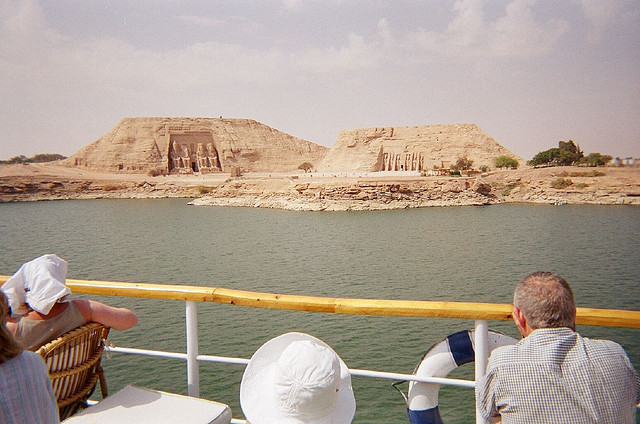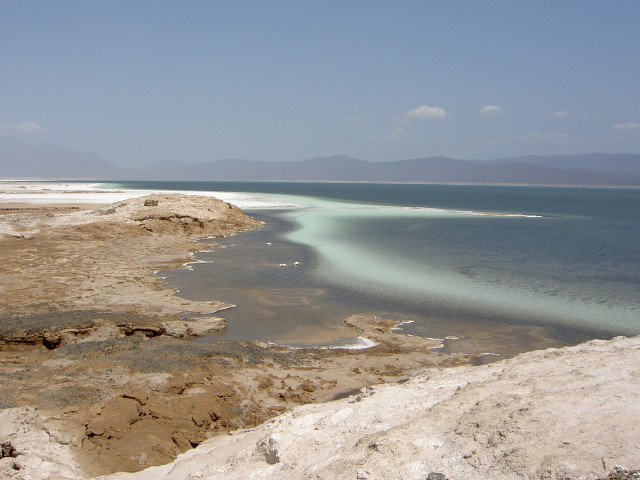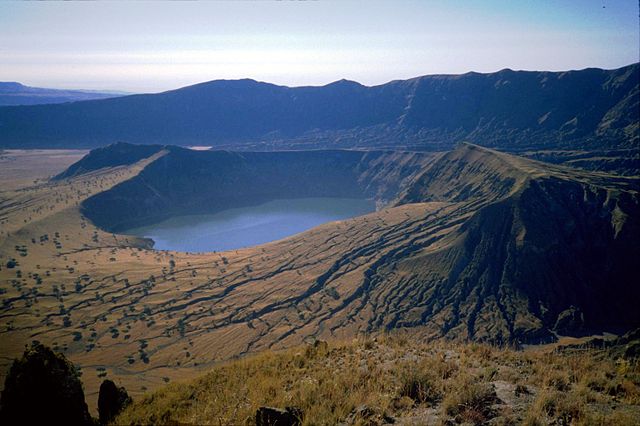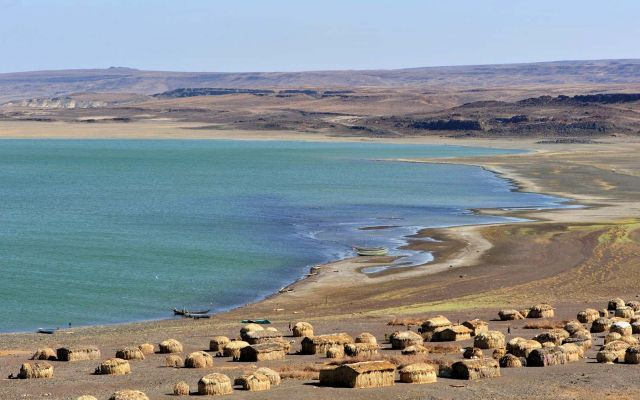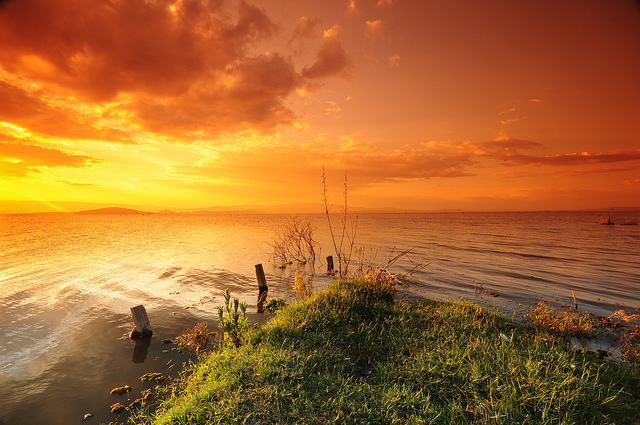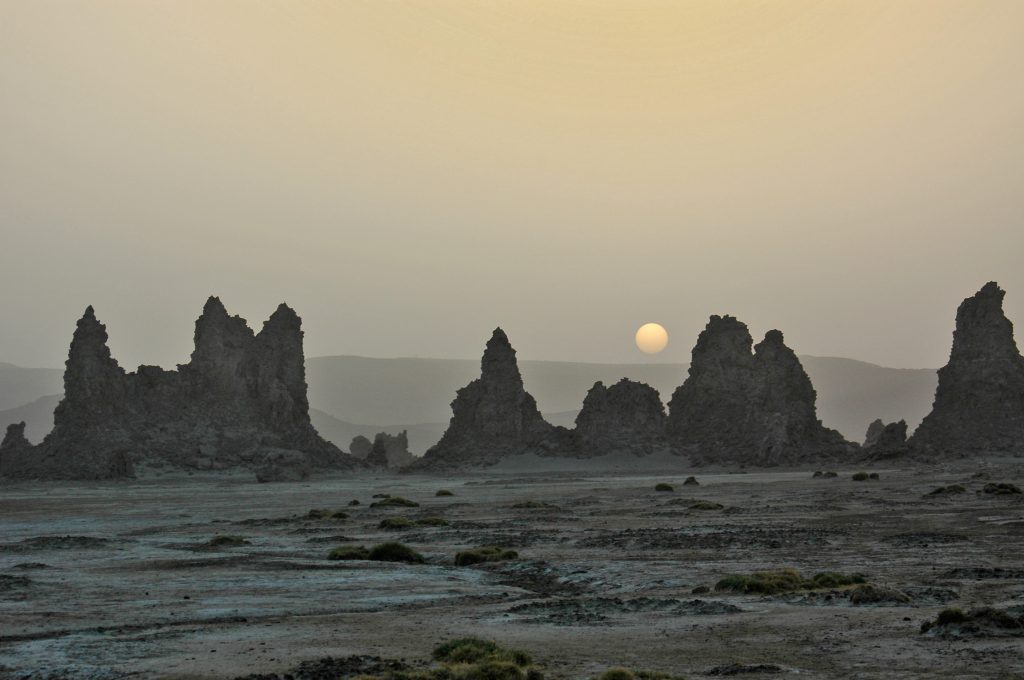The second largest continent on Earth, Africa is a place of incredible diversity in every aspect — biologically, culturally, and geographically. With 54 countries and dozens of unique bio-regions, there are plenty of lakes that support human, plant, and animal life. Some are the largest freshwater bodies in the world and some are highly caustic, supporting only uniquely adapted life. Either way, they’re all made for visiting whether you’re observing moon-like landscapes and salt ponds, scuba diving, or enjoying a cocktail during sunset. Here are the 15 lakes in Africa you have to visit.
1) Lake Tanganyika
One of the most impressive bodies of water in the world, Lake Tanganyika is the second largest and second deepest freshwater lake on Earth. Divided between Democratic Republic of Congo, Burundi, Zambia, and Tanzania, the most accessible parts of the lake are in Burundi and Tanzania where you’ll find thatch-hut bungalows, ice cold beers, boats for rent, and of course, delicious fish dinners over spectacular sunsets.

Courtesy of lucianf/Flickr.com
2) Lake Malawi
Third largest and second deepest in Africa, Lake Malawi stretches nearly the entirety of Malawi as well as touching Mozambique and Tanzania. Fresh, clear water and white sand beaches are what you’ll find should you visit and like Tanganyika, eco-resorts abound on its shores. Malawi sees a steady stream of tourists and there are plenty of opportunities for water activities from boating, kayaking, snorkeling, to scuba diving.
3) Lake Nasser
Lake Nasser is one of the largest manmade bodies of water in the world. Egypt constructed the Aswan High Dam on the Nile between 1958 and 1971, permanently flooding the southern Egyptian portion of the Nile into Sudan. Impressively, the temples of Abu Simbel were disassembled piece by piece and faithfully reconstructed nearby. The entire area is ideal for exploring other ruins and cruising on local dhows.
4) Lake Chad
If you’re planning on visiting Lake Chad, you had better hurry. According to some estimates, the lake has shrunk up to 90% over the past 50 years. Recent images show improvement which is great news for the 70 million people who rely on it for water and fishing in Chad, Cameroon, Niger, and Nigeria. The easiest way to visit is likely from the Chadian capital N’Djamena, though, that’s not saying much due to the instability of the area. Amazing wetlands and wildlife can be found here, however.
5) Lake Assal
Lake Assal is awesome for several reasons. It is one of the most saline bodies of water on the planet, it’s a big draw in little Djibouti, it’s the third lowest land depression on Earth and the lowest in Africa at over 500 feet below sea level. Camels, salt flats, antelopes, and shrubs are what you’ll find should you visit this Martian-like landscape.
6) Lake Nakuru
If you want to see wildlife at a lake, Nakuru in Kenya is the place to be. Famous for thousands upon thousands of flamingos that are attracted to the algae the lake offers, Nakuru has plenty of other birds as well as warthogs, baboons, giraffes, and re-introduced rhinos (both white and black). Located in central Kenya, this national park is close to many others in the region.
7) Deriba Crater Lake
Probably the least visited on the list, Deriba Crater is the highest point of Jebel Marra Mountain in the Darfur area of Sudan. Despite the low number of tourists, the lake itself is one of the most breathtaking. Hopefully, stability returns to the region soon and visitors will be able to appreciate the lake in all its majesty.
8) Lake Volta
Lake Volta in Ghana is the largest reservoir in the world by surface area. Formed in 1965, the Akosombo Dam provides hydroelectricity for most of the country and nearby Togo and Benin. With rolling green hills diving into the water, there are plenty of places to stay on Volta’s shores as well as ample opportunity for fishing, swimming, or cruising its waters in a traditional pirogue.
9) Lake Turkana
A UNESCO World Heritage Site, Lake Turkana is in Kenya’s seldom-visited extreme north on the border with Ethiopia. The world’s largest desert and alkaline lake, the landscape around Turkana is rocky volcanic desert. With plenty of fish, birds, mammals, and formerly, the largest concentration of Nile crocodiles, the area is best explored with a guide and four wheel drive vehicle. The indigenous peoples of northern Kenya who inhabit the area are no less fascinating as well.
10) Lake Natron
The reddish-brown waters of Lake Natron are caused by its chemical makeup – it’s a salt and soda lake in northern Tanzania and unlike most places in the world, let alone Africa. Extremely high temperatures and salt content make it inhospitable for most predators meaning it’s a safe haven for migratory birds. Photographer Nick Brandt has taken some incredible photos of calcified flamingos and other animals in a new photography book.
11) Lake Naivasha
Naivasha’s name comes from the local Maasai name ‘Nai’posha’ meaning rough water due to the sudden onset of fierce storms that can plague it. One of Kenya’s Great Rift Valley lakes, over 400 species of birds have been observed here. Hippos thrive and the lake can be easily visited from Nairobi in an hour or two and is a great way to get out of the big city for a weekend.
12) Lake Kivu
Split between Rwanda and the Democratic Republic of Congo, Lake Kivu is much more accessible on its eastern shore. Featuring volcanic sands in the north, the lake sustains millions in the area who fish by lantern at night in three-tiered canoes called isambaza. Resorts dot its shores on both sides and at least on Rwanda’s, the area is ideal for hiking, swimming, lounging on the beach, or just soaking up the view with some fresh fish and a cold beer.
13) Lake Tana
Ethiopia’s Lake Tana is the source of the Blue Nile and one of the coolest places in the country. Nearby are the Blue Nile Falls and the island of Tana Qirqos features a monastery where Ethiopian Orthodox monks are the only inhabitants. The area is rich in wildlife, accommodation, and water activities and should be on any itinerary to Ethiopia.
14) Lake Abbe
Another salt lake on the border between Djibouti and Ethiopia, Abbe features salt flats, colored water, and lunar landscapes. Limestone pillars rise out of the ground to heights of over 50 meters (150 feet) and spew hot steam from deep within the Earth. Tour operators can bring you there for the ethereal experience and it is one of the top things to do and see in Djibouti.
15) Lake Victoria
The second largest freshwater lake by surface area, Lake Victoria is split between Tanzania, Kenya, and Uganda. Some say the source of the White Nile is from the lake which feeds into the rapids near Jinja, Uganda, famed for its white water rafting. The Ssese Islands in Uganda feature plenty of eco-resorts and northern Tanzania has some spectacular national parks that are either wetlands or islands as well.
More from AFKTravel:
The Beauty Of Lake Malawi In Photos
The Top Luxury Lodges In Lake Nakuru, Kenya
The Haunting Beauty Of Lake Natron
Want to discover the finer side of Africa? Sign up for our weekly newsletter.

